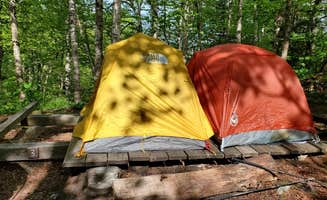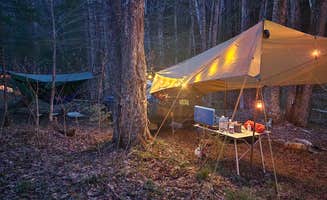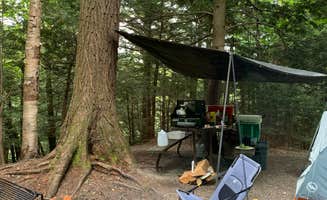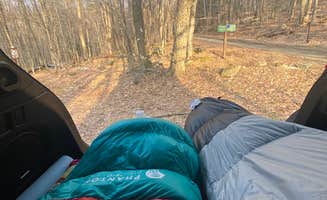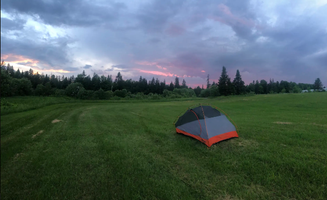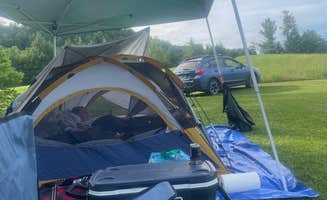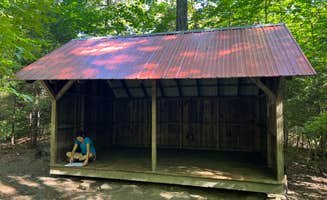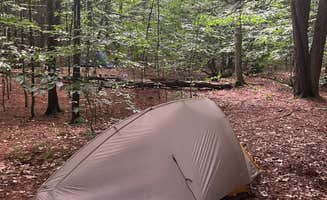Dispersed camping opportunities in the Green Mountain National Forest surrounding Waitsfield, Vermont extend beyond the popular Forest Road 25. The region sits at elevations ranging from 700 to over 4,000 feet, creating diverse microclimates for campers. Several lesser-known riverside and woodland sites accommodate tent camping throughout the May-October season, when nighttime temperatures can drop to the 40s even in summer.
What to do
Hiking and swimming: At Camel's Hump State Park, access a designated primitive camping area about 1.5 miles into the trail. "This is a short and sweet hike to one of the higher points in Vermont. It is a beautiful scenic (somewhat strenuous) hike to the summit. The views are pretty epic though," reports Kate K.
Fishing and boating: The Indian Brook Reservoir offers tent platforms accessible by foot or boat. "The Reservoir lends itself to peaceful boating, nature watching and great fishing," according to M.A.D. P. Note that sites require a 15-minute hike from parking: "If you have a kayak, you can transport your stuff over," advises Erin B.
Snowshoeing and winter camping: Michigan Brook Road provides winter access for hardy campers. "The main road to the parking lot is plowed and sanded. However if you would like to continue down the service road during winter months I would highly recommend snowshoes or a snowmobile," writes Keegz M. Winter campers should note there's no cell service at the campsite, but service is available at the end of upper Michigan Brook road.
What campers like
Privacy and nature sounds: Tent campers appreciate the seclusion at Patterson Brookside camp on West Hill Road, where "Mountain road lingers along the river. There's quite a few sites along the road... Peaceful! Gorgeous rock river," according to Thomas and James S. Sites feature established fire rings but no services.
Night sky viewing: Mount Philo State Park offers exceptional stargazing. "Totally beautiful, private spots, pit toilets and a night sky to die for!" raves Molly G. The park has only 8 campsites, creating a more intimate camping experience.
Swimming holes: The Route 100 area includes natural water features. "This site has 3-5 campsites right off of route 100. This is right next to Mad River with a area to walk down into a swimming hole. Great place," writes Margaret E. These sites are technically day-use areas, so check current regulations.
What you should know
Cell service limitations: Most dispersed camping areas lack reliable communications. At Michigan Brook Road camping, a reviewer notes: "THIS LOCATION DOES NOT PROVIDE CELL PHONE SERVICE OR WIFI CONNECTION. However, if you walk to the end of upper Michigan Brook road you will have cell phone service and a gas station along with a United States Post Office as well as a general store."
Waste management: Green Mountain National Forest FR25 posts warnings about proper sanitation. "There was a NFS sign along FR-25 posted asking people to clean up after themselves (litter and human waste) as there'd been complaints to the extent that they were considering closing the sites if people didn't do better," reports Helen P. All dispersed camping requires packing out waste.
Seasonal road conditions: Access varies by season. "Road goes in pretty far. Some parts are muddy and very rough. Higher clearance would be advised!!!" warns Thomas and James S. about Michigan Brook Road. Winter access requires different planning than summer visits.
Tips for camping with families
Platform tents: For families new to tent camping near Waitsfield, Vermont, consider Underhill State Park which offers lean-tos. "This is the best of car camping - you get the feel of really being out in the woods, with your car a short distance away. They provide wheelbarrows for easy moving of your stuff," explains Ali T.
Gear transport: Families should pack efficiently for hike-in sites. At Indian Brook Reservoir, one parent advises: "I mistakenly assumed they had drive up campsites. They do not. It was a 15 minute hike to the site, so pack light."
Stream access: Look for sites with safe water features. At Patterson Brookside camp, campers can enjoy the riverside setting where dirt sites line the water. Remember these sites lack facilities: "There is no electricity, no cell coverage, not outhouses in this area. Be prepared to pack out everything you bring in."
Tips for RVers
Size restrictions: RVers have limited options for dispersed camping. Green Mountain National Forest camping areas like Michigan Brook and FR25 can accommodate small trailers or campervans, but not large rigs. "I found most of the spots to be on the road before the GPS marker. Few nice ones near the creek," reports one camper at Michigan Brook Road.
Established alternatives: For larger RVs, Mount Philo State Park offers a structured option. "Nice trails that lead to scenic views of Lake Champlain. Bathrooms and showers were clean. Showers were quarter operated, 50 cents for 5 minutes. Firewood sold on site," notes Beau B., though the "steep and winding" road isn't suitable for large RVs.
Generator restrictions: Most dispersed camping areas prohibit generators. At Route 100, the proximity to other campers and day users requires quiet camping. Consider solar options for power needs at primitive sites.


